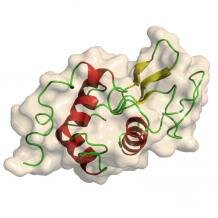Topic: Lysozyme
Lysozymes are common antibacterial enzymes that protect our eyes and nose from infection, but some animals have recruited them for a rather different purpose...
Lysozyme (also called muramidase or N-acetylmuramide glycanhydrolase) refers to a family of enzymes  that are found in virtually all animals but also in plants and bacteriophages. As it can damage bacterial cell walls by cleaving the linkages between their components, lysozyme serves as an antibacterial defence and is part of the innate immune system. In vertebrates, it is contained in white blood cells and tissue macrophages and found in a number of secretions (such as tears, saliva, nasal mucus and human milk) as well as in avian egg white. Some lysozymes, particularly those of plants and invertebrates, are also able to degrade chitin. However, a number of animals rely on lysozyme for a rather different purpose…
that are found in virtually all animals but also in plants and bacteriophages. As it can damage bacterial cell walls by cleaving the linkages between their components, lysozyme serves as an antibacterial defence and is part of the innate immune system. In vertebrates, it is contained in white blood cells and tissue macrophages and found in a number of secretions (such as tears, saliva, nasal mucus and human milk) as well as in avian egg white. Some lysozymes, particularly those of plants and invertebrates, are also able to degrade chitin. However, a number of animals rely on lysozyme for a rather different purpose…
In foregut fermenters
Several groups of herbivores have independently evolved foregut fermentation, a digestive strategy, whereby indigestive plant material is broken up with the help of microbes in a chamber anterior to the stomach. In many of these animals, lysozyme has been recruited as a bacteriolytic enzyme in the true stomach as a further adaptation to plant eating. Here its new function is to digest the fermentative bacteria passing through the gut (which are only slowly lysed by conventional digestive enzymes) and thus to prevent loss of the nutrients that these microbes have assimilated. In the stomach of ruminants, lysozyme is the most abundant protein, but, interestingly, it has also been isolated from the stomachs of bacteria-ingesting molluscs and insects as well as the caeca of hindgut fermenters. This supports the notion that this enzyme is adapted to utilising bacteria as food.
 In order to function in the stomach fluid, which is acidic and contains the proteolytic enzyme pepsin, the stomach lysozymes of foregut fermenters had to undergo several changes, probably facilitated by gene duplications. Most importantly, they needed to obtain a lower pH optimum and become resistant to pepsin. This has been achieved by substitutions at specific amino acid sites. Furthermore, regulatory changes were necessary to achieve high levels of expression in the stomach. The biochemical properties of the stomach lysozymes of different foregut fermenters are similar, probably as a result of convergent evolution of amino acid sequences (although one analysis suggested that parallel evolution might actually be more significant).
In order to function in the stomach fluid, which is acidic and contains the proteolytic enzyme pepsin, the stomach lysozymes of foregut fermenters had to undergo several changes, probably facilitated by gene duplications. Most importantly, they needed to obtain a lower pH optimum and become resistant to pepsin. This has been achieved by substitutions at specific amino acid sites. Furthermore, regulatory changes were necessary to achieve high levels of expression in the stomach. The biochemical properties of the stomach lysozymes of different foregut fermenters are similar, probably as a result of convergent evolution of amino acid sequences (although one analysis suggested that parallel evolution might actually be more significant).  It is likely that the number of ways in which a conventional lysozyme can be modified into a stomach lysozyme is limited.
It is likely that the number of ways in which a conventional lysozyme can be modified into a stomach lysozyme is limited.
The stomach lysozymes of ruminants and colobine monkeys are very similar in their characteristics. Sequence analysis suggested that langur lysozyme converged upon cow lysozyme after langurs had become foregut fermenters and evolved twice as fast as the lysozymes of other primates. Likewise, ruminants and colobines employ the RNA-cutting enzyme pancreatic ribonuclease (pRNase) for digestive purposes, which is linked with a gene duplication in the latter group.
 A foregut-fermenting folivorous bird, the hoatzin (Opisthocomus hoazin), has independently recruited lysozyme as a digestive enzyme, again involving rapid amino acid sequence changes. The hoatzin stomach contains high levels of lysozyme, but in contrast to that of mammalian foregut fermenters it is of the calcium-binding and not the conventional type. This represents a particularly intriguing case of molecular convergence, because “biochemical convergence and parallel amino acid replacements are observed in the hoatzin stomach lysozyme even though it has a different genetic origin from the mammalian examples and has undergone more than 300 million years of independent evolution” (Kornegay et al. 1994, Molecular Biology and Evolution, vol. 11, pp. 921-928).
A foregut-fermenting folivorous bird, the hoatzin (Opisthocomus hoazin), has independently recruited lysozyme as a digestive enzyme, again involving rapid amino acid sequence changes. The hoatzin stomach contains high levels of lysozyme, but in contrast to that of mammalian foregut fermenters it is of the calcium-binding and not the conventional type. This represents a particularly intriguing case of molecular convergence, because “biochemical convergence and parallel amino acid replacements are observed in the hoatzin stomach lysozyme even though it has a different genetic origin from the mammalian examples and has undergone more than 300 million years of independent evolution” (Kornegay et al. 1994, Molecular Biology and Evolution, vol. 11, pp. 921-928).
Interestingly, things seem to be different in sloths. A study on three-toed sloths (Bradypus variegatus) provided evidence for at least three isoforms of lysozyme, which were active in different parts of the gut. But the secretion and activity pattern of the enzyme as well as its low overall concentration suggested that lysozyme has a different, more primary function in sloths compared to other foregut fermenters. It probably protects the symbiotic gut microflora from foreign bacteria, thus allowing the animals to be successful folivores.
Cite this web page
Map of Life - "Lysozyme"
https://mapoflife.org/topics/topic_255_lysozyme/
March 3, 2021

